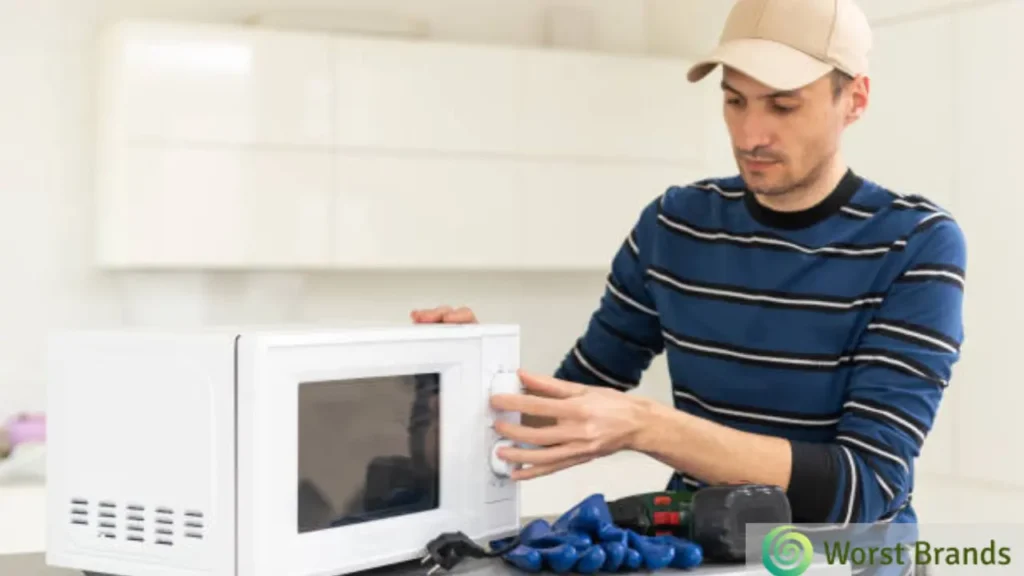Are you struggling with an LG microwave that won’t heat food? You’re not alone.
This issue, common among many households, often leads to unnecessary stress and the premature decision to purchase a new appliance. However, the solution might be simpler than you think.
With a blend of technical insight and practical tips, this guide will walk you through the most common reasons and fixes for an LG microwave that’s not heating.
Pro Tip: Quickly fix your LG microwave not heating by resolving power supply problems, disabling the child lock, and replacing a burned-out diode or magnetron.

Table of Contents
Troubleshooting LG Microwave Not Heating?
Before you consider replacing your appliance, let’s dive into why your LG microwave stopped heating and how you can fix it.
1. Power Supply Issue
Your LG microwave’s heating efficiency hinges on a consistent and stable power supply.
Variations or interruptions in power can be a silent culprit, leading to your microwave’s inability to heat.
It’s often overlooked, but this fundamental aspect is crucial to the appliance’s performance.
Similar power-related issues are also the cause of Kenmore microwave heating problems.
How to Fix:
Begin by ensuring your microwave is directly connected to a wall outlet.
While convenient, using multiplugs or power strips can sometimes cause power inconsistencies.
Next, inspect your home’s circuit breaker. Look for any tripped switches and reset them if you find any. This is a common fix for sudden power disruptions.
If the problem continues, consider testing another outlet. Sometimes, the issue might be with the outlet itself rather than the microwave.
This simple but effective troubleshooting can save you from unnecessary repairs or replacements.
2. Child Lock Enabled
The child lock is a safety feature in your LG microwave designed to prevent accidental operation, particularly by children.
However, this feature can sometimes be activated unintentionally, leading to the microwave not heating.
Recognizing this as a potential issue is vital, especially if children in the household might interact with the appliance.
How to Fix:
To resolve this, first, locate the ‘L’ icon on your microwave’s control panel. This symbol indicates that the child lock is engaged.
Press and hold the START/ENTER button for about 4 seconds.
You should hear a beep sound, signaling that the child lock is now disabled. If this doesn’t work, an alternative method is to reset the microwave.
Unplug it from the power source for 2-3 minutes. This action should reset the system and, in turn, disable the child lock.
Restoring your microwave to its functional state can be as simple as recognizing and toggling this often-missed feature.
3. Demo Mode Activated
Demo mode in your LG microwave serves a unique purpose, primarily for retail displays. It allows the microwave to showcase its features without actually heating.
This mode can sometimes be inadvertently activated or left on, especially in new purchases, leading to the microwave not heating while other functions seem operational.
Recognizing this mode’s activation is essential for troubleshooting.
How to Fix:
The most straightforward method to exit demo mode is a basic reset.
Simply unplug your microwave, wait a few moments, and then plug it back in.
This action resets the microwave to its default factory settings, typically deactivating demo mode.
It’s a quick, no-fuss solution that restores full functionality to your microwave without navigating complex settings or menus.

4. Faulty Door Switch
A malfunctioning door switch is a common yet often overlooked reason for an LG microwave not heating food.
This switch is a critical safety feature, preventing the microwave from operating when the door opens.
If this switch fails, it can erroneously signal that the door is open, even when it’s securely closed, thereby inhibiting the heating process.
How to Fix:
First, ensure the microwave is turned off and unplugged for safety. Using a multimeter, test the door switch for continuity – a continuous electrical path is present in the switch.
If the test indicates a lack of continuity, the switch is faulty and requires replacement.
Due to the technical nature of this repair, it is recommended to contact LG support for guidance or arrange for a professional switch replacement.
Handling this component incorrectly could lead to further damage or safety hazards.
5. Disable Active Timer
The active timer in your LG microwave is a separate function from the cooking settings.
It’s designed for timing activities unrelated to cooking, like standing time for certain recipes.
However, when activated, it can prevent the microwave from heating, leading to confusion and the misconception that the LG microwave is malfunctioning.
How to Fix:
Disabling the active timer is straightforward. Press the ‘Timer on/off’ button on your microwave’s control panel.
This action should switch the microwave from timer mode back to its standard cooking functionality. It’s a simple yet often overlooked step in troubleshooting the LG microwave heating problem.

6. Thermal Fuse Blown
The thermal fuse in your LG microwave is a safeguard against overheating.
When the internal temperature of the microwave exceeds safe limits, this fuse blows, cutting off power as a protective measure.
Once blown, the microwave ceases to heat, which could be mistaken for other malfunctions.
Interestingly, this issue is a common reason for Whirlpool microwave not heating.
How to Fix:
Replacing a blown thermal fuse is the only solution.
Before attempting any repairs, ensure the microwave is unplugged and fully discharged to avoid any electrical hazards.
Locate and remove the blown fuse, then replace it with a new one.
This procedure might require technical know-how, as it involves handling sensitive microwave components.
If you’re uncomfortable, seeking professional assistance is wise to ensure safety and effectiveness.
7. Burned Out Diode
The diode in your LG microwave is crucial in powering the magnetron by directing electricity.
If this diode burns out, the magnetron won’t receive the voltage it needs, leading to the microwave not heating.
Diode failure can occur due to a range of issues, including power surges or general wear and tear.
How to Fix:
Replacing a burned-out diode is a more manageable task compared to other microwave repairs.
First, identify the diode location, which is typically near the high-voltage capacitor.
After ensuring the microwave is unplugged and safe to work on, check the diode for visible signs of damage.
If a replacement is needed, source the correct part based on your microwave model.
For those not confident in their DIY skills, seeking professional help is advised to ensure safety and effectiveness.
8. Magnetron Burned Out
The magnetron is responsible for generating the microwaves that heat your food.
However, like any crucial component, it’s vulnerable to failure, often due to power surges or general wear over time.
When the magnetron burns out, it directly impacts the microwave’s ability to heat, leading to a common but significant issue in microwave ovens.
Understanding the role of the magnetron in your microwave’s functionality is key in troubleshooting LG microwave problems.
How to Fix:
Replacing a burned-out magnetron is not a simple DIY task. It requires specific technical knowledge and tools, making it a job for a professional.
The first step is to contact LG customer support, who can guide you through the process. They will likely recommend a certified technician to handle the replacement.
Attempting to replace the magnetron yourself can be dangerous and might lead to more damage or voiding your warranty.
A professional technician will ensure the replacement is done safely and correctly, restoring your microwave to its full heating capabilities.
Also Read: Samsung Microwave Not Heating
Conclusion
We’ve explored various reasons and fixes for the LG microwave heating problem, ranging from simple user errors to more complex component failures.
While some issues, like a tripped power supply or an engaged child lock, can be resolved at home, others, like a burned-out magnetron or diode, might require professional intervention.
The key is approaching each problem methodically, ensuring safety and accuracy in your troubleshooting steps.
Doing so can often restore your microwave’s functionality without costly replacements, effectively fixing your LG microwave not heating food.

Steven Settles is an ISCET-certified master in appliance repair. He has aced the National Appliance Service Technician Certification Exam, showcasing his exceptional diagnostic and repair skills. With an in-depth understanding of the latest repair technologies and a keen eye on evolving industry standards, Steven is a go-to expert for any appliance issue.